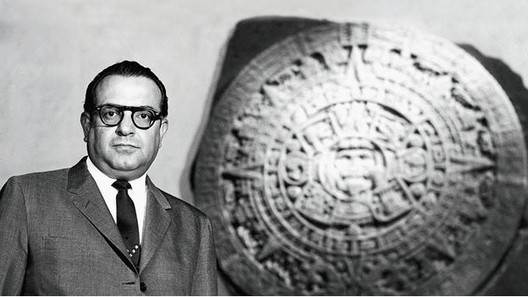
Pedro Ramírez Vázquez, one of the most important Mexican architects of the 20th century, died yesterday on his 94th birthday in Mexico City. Ramírez headed the construction of many of Mexico's modernist landmarks including several museums, the nation's largest sports stadium and a shrine that attracts the most pilgrimages in the country.
Read more on Pedro Ramírez Vázquez and his architectural legacy after the break.
Ramzírez was born in Mexico City on April 16, 1919, just at the end of the Mexican Revolution. He studied architecture at the national university and graduated in 1943, becoming the protégé of Jaime Torres Bodet. Bodet was a politically connected intellectual who was named Secretary of Education that same year and began a nationwide school construction campaign. Under Bodet, Ramírez developed a low-cost, prefabricated prototype for classrooms and teacher housing that was used for decades at thousands of rural school sites all over Mexico.
In the years that followed, Ramírez headed the designs for the medical school at his alma mater, the Mexico pavilions for World’s Fairs in Brussels (1958), Seattle (1962) and New York (1964) and the Azteca Stadium, the nation's largest sports facility (1965). He helped organize the country's first Olympics in 1968 and unfortunately faced much controversy after a violent army attack against antigovernment protestors took place just before the games.
This political scrutiny was perhaps due to the fact that Ramírez was not only an architect but somewhat of a politician, as Luis M. Castañeda, a professor of art history at Syracuse University explains. “He knew how to maximize windows of opportunity not only to produce structures but to expand the definition of what an architect is and does,” he said in a 2012 interview. “To think of him as somebody who designed buildings is not to take account of all the roles he played. He wasn’t the one constructing the models or sketching the drawings; he was the one securing the commission from the president.”
Despite the politicized attention Ramírez faced during the Olympic games and in the construction of many federal projects, he will be best remembered for his design of the National Museum of Anthropology in Mexico City, his "richest architectural legacy." Miquel Adriá, director of the architectural magazine Arquine, says that Ramírez "succeeded in projecting in modern form many aspects that we had found in Mexican architecture from pre-Hispanic on into colonial times, including a generous use of space and the element of monumentality.” In the museum's construction, Ramírez oversaw many subordinate architects and engineers, some of Mexico's finest muralists and archaeologists and ethnographers who extracted national artifacts from every corner of the country to be displayed in the new museum.
The museum opened in 1964 at the base of the Chapultepec Park, clad in marble and with 26 exhibition rooms that surround a large central patio. At the center of this patio a colossal pillar supports an umbrellalike roof, from which a fountain showers rainlike water to flagstones below. A geometric grill reminiscent of ancient Mayan ornamentation encloses the museum's second floor, creating a monumental scale and ceremonial air that still leave an impression on thousands of visitors every day.
This is how Pedro Ramírez Vázquez should be remembered - for leaving behind a more modernist and monumental Mexico that, through built form, celebrates its past while embracing its future.
Reference: NYTimes

